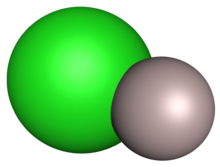Aluminium monochloride

| |

| |
| Names | |
|---|---|
| IUPAC name
Chloridoaluminium[1]
| |
| Other names
Aluminium(I) chloride[citation needed]
| |
| Identifiers | |
3D model (
JSmol ) |
|
| ChEBI | |
| ChemSpider | |
PubChem CID
|
|
CompTox Dashboard (EPA)
|
|
| |
| |
| Properties | |
| AlCl | |
| Molar mass | 62.43 g·mol−1 |
| Thermochemistry | |
Std molar
entropy (S⦵298) |
227.95 J K−1 mol−1 |
Std enthalpy of (ΔfH⦵298)formation |
-51.46 kJ mol−1 |
| Related compounds | |
Related compounds
|
aluminium monofluoride gallium monofluoride |
Except where otherwise noted, data are given for materials in their standard state (at 25 °C [77 °F], 100 kPa).
| |
Aluminium monochloride, or chloridoaluminium is the metal halide with the formula AlCl. Aluminium monochloride as a molecule is thermodynamically stable at high temperature and low pressure only.[2] This compound is produced as a step in the Alcan process to smelt aluminium from an aluminium-rich alloy. When the alloy is placed in a reactor that is heated to 1,300 °C and mixed with aluminium trichloride, a gas of aluminium monochloride is produced.[3]
- 2 Al(alloy) + AlCl3(gas) → 3 AlCl(gas)
It then disproportionates into aluminium melt and aluminium trichloride upon cooling to 900 °C.
This molecule has been detected in the interstellar medium, where molecules are so dilute that intermolecular collisions are unimportant.[4]
See also
References
- ^ "chloridoaluminium (CHEBI:30131)". Chemical Entities of Biological Interest (ChEBI). UK: European Bioinformatics Institute.
- ISSN 0047-2689.
- ISBN 0-8247-0896-2.
- Bibcode:1987A&A...183L..10C.
